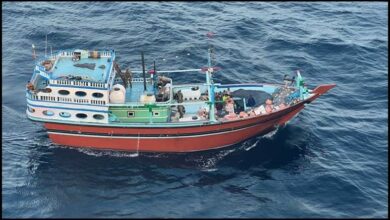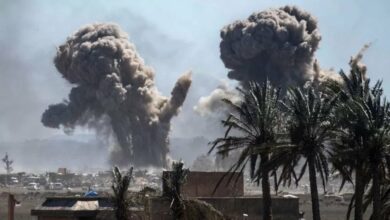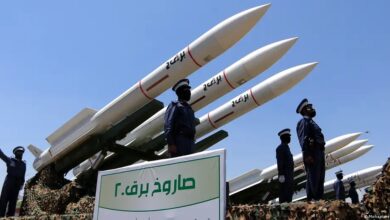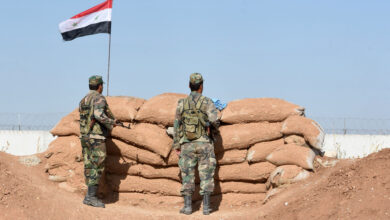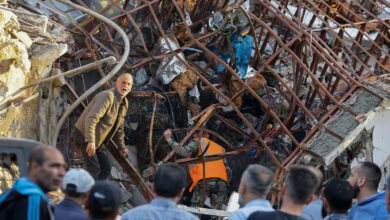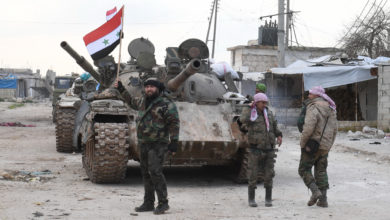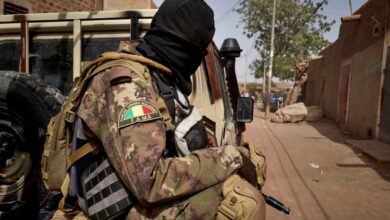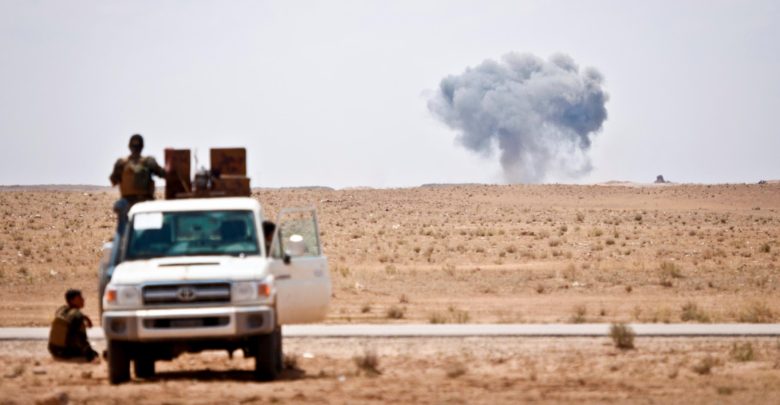
The U.S. is withdrawing most of its forces from Syria, based on an October 6 decision by President Donald Trump. However, several hundred troops may remain in strategic areas of the Euphrates river valley. Trump has described this as “securing the oil,” which is the newest iteration of Washington’s changing Syria policy goals. The oil facilities, if they are secured, could create a corridor of U.S. control and influence that helps keep prevent an Islamic State resurgence and also may reduce or impede Iranian influence near the Iraqi border.
Trump said the U.S. had “secured the oil” in eastern Syria in comments on October 20 and 23. He also indicated the U.S. would continue to work with the Syrian Democratic Forces, who will keep ISIS members under “strict lock and key.”
U.S. Secretary of State’s Special Representative for Syria Engagement James Jeffrey told the Senate Foreign Relations committee on October 22 that the U.S. goal in Syria still envisioned getting Iran out of Syria. That goal would be pursued diplomatically, he said.
Across the eastern border, U.S. and counter-ISIS Coalition forces continue to advise the Iraqi Security Forces in their fight against ISIS, through training and Security Forces Assistance Brigades.
American troops already in Iraq are there at the invitation of Baghdad but their role has become increasingly controversial amid tensions between the U.S. and Iran, and after Trump in December suggested the U.S. might use Iraq to “watch” Iran.
The U.S. withdrawal from northern Syria was supposed to be orderly and deliberate. Troops crossed from Syria into the Kurdistan region of northern Iraq, but their stay in Iraq may be temporary because Iraqi authorities have indicated they don’t have permission to be based there for more than a few weeks.
With protests across central and southern Iraq, the future U.S. role in parts of Iraq is in question.
Continuing the US presence in southern Syria
Trump’s decision to withdraw troops from Syria did not include the Tanf garrison near the Jordanian border. This outpost, used by special forces to train the few remaining Vetted Syian Opposition anti-ISIS fighters, has also been seen as important for denying Iran one route towards the Golan in western Syria, impeding its threat to Israel.
ISIS uses the Iraq-Syria border area as a place to hide out, and ISIS sleeper cells carry out near-daily attacks in Iraq and Syria. This means the assertion that the U.S. is just securing oil in Syria provides the basis for doing much more than that, and it makes sense for the U.S. to keep some forces in the Middle Euphrates River Valley area of southern Syria, near the last territory ISIS held until March when its “caliphate” was defeated on the ground.
When Trump first decided to withdraw from Syria in December, U.S. forces were already reduced to a light footprint of special forces personnel. Leaving several hundred troops in southern Syria will keep the U.S. military in the MERV.
The MERV is primarily rural and desert in some areas, but it is home to numerous tribes who were important in the conflict. That the campaign to defeat ISIS there took almost a year, a testament to how complex it was.
In June 2018, Andrew Tabler of The Washington Institute for Near East Policy noted that there were six large tribal confederations in the area: Walda, Afadla, Sabkhha, Busaraya, Baggara and Ougaidat. “The US and its allies can win sympathy from the tribes by acting consistently and committing to stabilization and reconstruction. Washington also as some room to capitalize on anti-Iran segment,” he wrote.
The SDF alliance sought to incorporate tribal elements as it expanded over the years, including the Al-Sanadid Forces and members of the Shaitat, who had suffered under ISIS.
The U.S. showed limited interest in the residents of the MERV, but the reduction of stabilization efforts after the first December withdrawal decision impacted the long-term goal of working with locals.
By June there were attempts by ISIS to create a resurgence in the MERV. A Pentagon Inspector General report noted that “ethnic differences between the Kurdish-led SDF and the majority Arab residents of the MERV, including Dayr az Zawr [Deir Ezzor] province, provide ISIS with an opening to retain a residual foothold.”
Extremists have used this area since long before ISIS. After the 2003 U.S. invasion of Iraq, the MERV was a corridor for foreign fighters seeking to fight Americans across the border in Anbar province. Due to this history of connections to insurgent groups that fought the U.S., there will be challenges in maintaining security as U.S. forces remain.
The U.S. and its SDF partners have been effective at combating sleeper cells, but ISIS might be emboldened by the current unsettled nature of the conflict as U.S. forces and the SDF move positions after agreements with the Syrian regime and Russia.
The SDF signed a military agreement with the Syrian regime on October 13 and Russia and Turkey signed another deal on October 22 that regulates how parts of northeastern Syria will now be run. Neither Russia or the Syrian regime want U.S. forces to remain, creating a complex diplomatic challenge for the U.S. in figuring out airspace control and deconfliction with the Russians, Syrian regime and Turkey.
The U.S. staying in the MERV, including around the al-Omar oil fields and the Conoco gas plant, will create a 120-km line of patrol from the Iraqi border to the area opposite Deir Ezzor city. The area east of the line will contain ISIS cells between the road along the Euphrates and Al-Shaddadi, which is 100 km to the east.
The U.S. will face a combination of Syrian regime forces, Russian contractors and Iranian elements on the eastern side of the Euphrates. Russian paramilitary contractors and Syrian regime forces already tried last February to test the U.S. and the SDF in a town near Deir Ezzor. The Syrians and Russians suffered numerous casualties.
Restricting Iran
A related problem is the presence of Iran-backed militias around Al Bukamal near the Iraqi border.
In June 2018, an airstrike was carried out on a Kataib Hezbollah base in Syria. Kataib Hezbollah is an Iraqi militia with close links to Iran. Since that strike, which was blamed on Israel, Iran has been accused of building a base near Bukamal, and recent Image Sat International satellite imagery shows new construction. More airstrikes hit this base in September. Nevertheless the nearby border crossing was ordered opened at the end of September to fanfare in Syria and Iraq.
Al Bukamal and Al Qaim in Iraq are believed to be on Iran’s “road to the sea” or “land bridge” that enables its forces to transport ordnance to Lebanese Hezbollah and allies in Syria.
In the wake of Trump’s Syria decision, U.S. Secretary of State Mike Pompeo traveled to Israel where he said the U.S. supports Israel’s right to act against Iran in Syria. Some Turkish voices have interpreted the U.S. decision to stay in the MERV as support for Israel’s desire that Iran be blocked in southern Syria.
The challenge for the U.S. as it consolidates its role in Syria to a presence in the MERV is tailoring its mission to this area. It will have the SDF on one bank and the Syrian regime and its allies on the other, and growing tensions between Israel and Iran in Syria could impact the U.S.
In the past after mysterious airstrikes in Iraq and at the Bukamal border area, some local Arab press and militia commanders of groups like Kataib Hezbollah have held the U.S. responsible.
It remains to be seen what posture the U.S. military chooses to keep in the MERV or how it intends to secure the oil fields. If it involves hundreds of soldiers and reinforcing those already present, as has been reported, it will be a significant presence for a relatively small but strategic area.
Seth J. Frantzman is the author of After ISIS: America, Iran and the Struggle for the Middle East (Gefen Publishing 2019). Follow him on Twitter @sfrantzman.
All views and opinions expressed in this article are those of the authors, and do not necessarily reflect the opinions or positions of The Defense Post.
The Defense Post aims to publish a wide range of high-quality opinion and analysis from a diverse array of people – do you want to send us yours? Click here to submit an Op-Ed.

